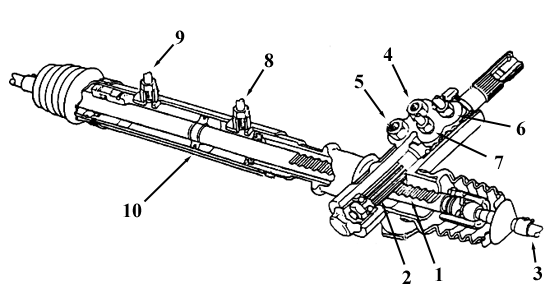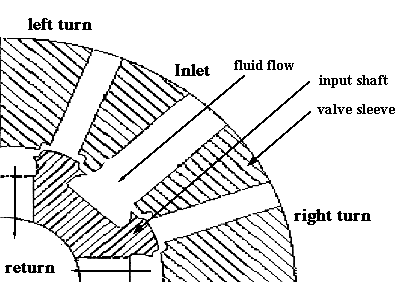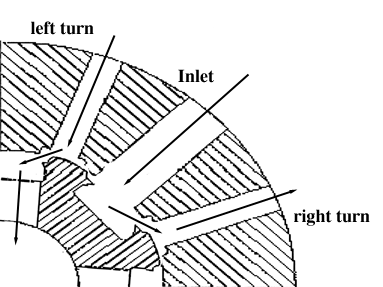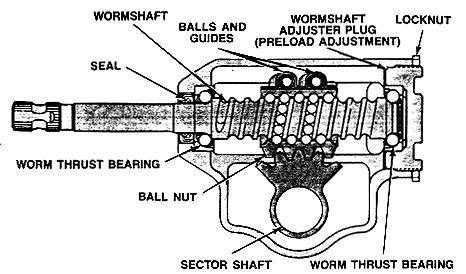
| MadSci Network: Engineering |
First, here's the quick answer as to how power steering works. A pump, driven by the engine, delivers pressurized hydraulic fluid to either side of the steering mechanism. This pressurized fluid pushing on the steering mechanism helps to steer the car and reduces steering effort. Remember, power steering is actually "power-assisted steering". It is not a drive-by-wire system. The power steering just helps the driver steer.
Here's the longer answer. There are two main parts to the power steering system: the pump and the steering gear. In most cases, the pump is attached to the front of the engine and driven by the accessory drive belt. The fluid reservoir (where you add fluid) is usually located on the pump. The pump should be sized to deliver sufficient fluid pressure at idle. As the pump spins faster as engine speed increases, a pressure relief valve is used to keep the pressure at the desired levels. In some cases, the engine driven pump may be replaced by an electric pump (therefore there won't be a belt running to the pump).
The interesting part of the system is the steering gear. There are two major types of steering gears used: rack and pinion, and recirculating ball type (aka worm and sector). Rack and pinion tends to be more prevalent with newer cars, so I'll discuss that type first.
Here's a cut-away view of a power assist rack and pinion.

The pinion (2) is attached to the steering shaft which is attached to the steering wheel. Thus, as the steering wheel is turned, the teeth in the pinion mesh with the rack (1) and slides the rack left and right. The rack is attached to the tie rods (3) which in turn attach to the knuckle (not shown) and tire. That's manual steering with a rack and pinion.
In the power assist system, fluid from the pump (high pressure side) enters the steering gear at (4) and returns (low pressure side) at (5). A valve system inside the gear box directs fluid out at (6) and (7) which re-enters the gearbox at (8) and (9). This pressurized fluid acts on the power piston (10) to assist steering. Thus, if the driver is turning right, additional fluid is directed to the right side of the piston, which helps move the rack and therefore steer the tires.
Fluid is directed to either the right or left sides by means of a rotary valve and torsion bar. Through this mechanism, the fluid pressure (and thus the amount of "assist") is proportional to the torque due to steering effort, and not the direction that the wheels are turned. In other words, it is possible for the system to help you turn left, even if the steering wheel is right of center. Here is a sketch of the rotary valve. Only one quarter is shown (it's symmetrical).

The torsion bar (a torsional spring) connects the steering shaft to the pinion. As stated at autoshop-online.com, "When the steering wheel is turned, resistance is created by the weight of the car and tire-to-road friction, causing a torsion bar in the rotary valve to deflect. This changes the position of the valve spool and sleeve, thereby directing fluid under pressure to the proper end of the power cylinder."
Here's another sketch of the rotary valve in a hard right turn.

As you can see, as the torsion bar twists, it changes the alignment between the input shaft and valve sleeve, delivering more pressure to one side, and less to the other.
A recirculating ball type system uses a different gear system, but the power assist system is essentially the same. Here's a picture of a manual recirculating ball system.

Essentially, the steering wheel turns a screw, which causes a "nut" to move back and forth along the screw. The movement of this nut causes the sector to move, causing the pitman arm to turn. In the power assisted version, pressure is applied in the same manner (via the torsion bar/rotary valve system) to either side of the "nut" to give power assist.
More information on steering systems can be found at Auto Shop Online.
Try the links in the MadSci Library for more information on Engineering.